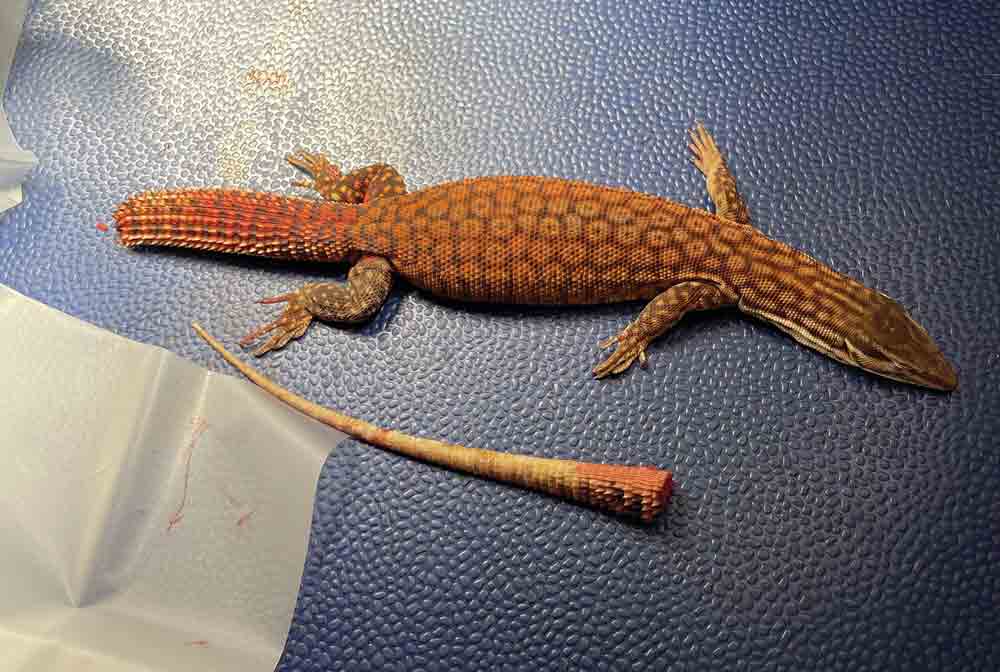A majority of amputations only need the tip or back quarter of the tail removed.
A surgical procedure I commonly perform on reptiles–especially lizards–are tail amputations. This article plans to explore the reasons this surgery is performed, the steps needed to perform such a procedure, the care after the surgery to help promote healing, and unique cases I’ve seen. A caveat before we begin–this is NOT a how-to guide to perform a tail amputation–if you feel your reptile is in need of surgery, please bring your pet to a qualified reptile veterinarian to assess and perform the procedure.
A tail amputation is indicated whenever there is a lesion compromising the continued health of the tail. This can be due to a variety of factors. Some of the common ones I see include dysecdysis (stuck shed) and trauma to the tail. Other indications for a tail amputation include cancerous masses or infections. Additionally, I am investigating how gout may affect the tail in my study on this disease in Odatria. If the lesion is left unchecked, it can cause necrosis, or tissue death, of the tail around the lesion. From here, this necrosis can spread up the tail, toward the body, and lead to systemic infection or even death.

When performing a tail amputation, regardless of the cause, care needs to be taken to make the incision in a way to allow healthy skin to appropriately close the surgical site. Photo by Dr. Eric Los Kamp
When performing a tail amputation, regardless of the cause, care needs to be taken to make the incision in a way to allow healthy skin to appropriately close the surgical site. This is important as this will protect the spinal cord from being exposed to the outside world. Usual after surgery care includes providing a sterile set up, antibiotics, and pain medication. Correcting the husbandry in the future to prevent the inciting issue from reoccurring and promoting healing is equally important. Ultimately, the amount of tail taken during the surgery depends on where the lesion is. A majority of amputations only need the tip or back quarter of the tail removed. Certain instances require more. I’ll go into two of the more intense cases I’ve seen.
One of these cases is my own ackie monitor, Tyranitar. He had a very rough shed that traumatized the underlying skin. While I tried to preserve this skin and his tail, the tissue started constricting and became bloodied/ulcerated. With this, to preserve his overall health, I needed to amputate half of his tail. He is currently healing and in a sterile set up right now. To understand why this occurred, I submitted the amputated tail for biopsy, which came back with infarction–occlusion of the vessels of the tail–causing severe necrosis with large amounts of bacteria.
Another of the interesting cases was a bearded dragon patient I saw in December 2022. He came to me with a black constricting lesion in the middle of the tail, and this particular dragon had lost an arm to a similar issue and had a lesion on its back. What’s more is that the black lesion look fuzzy, almost like a mold. My main concern was yellow fungus, a very contagious and deadly fungal infection that affects bearded dragons. To give this lizard the best shot at survival I needed to take the entire tail. To date, this is the most radical tail amputation I’ve performed, and the lizard is currently doing well! We sent out his tail for biopsy and it came back as yellow fungus. He is on medications for not only the surgery but also his disease and is currently doing well! We are monitoring him frequently to make sure that there aren’t any other occurrences of the fungus as well.
In conclusion, tail amputations are necessary to protect your pet from ascending infections, cancer, and other diseases.
Eric Los Kamp, DVM is an exotic animal and wildlife veterinarian at Winter Park Veterinary Hospital in Winter Park, Florida who has aspirations to board certify in reptile/amphibian medicine. In addition to being a member of the Association of Reptile and Amphibian Veterinarians (ARAV), he is an avid ackie monitor keeper.

